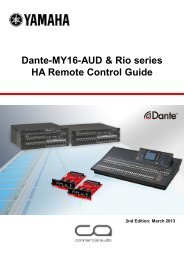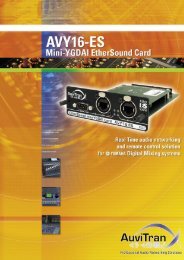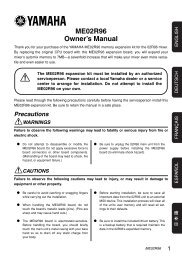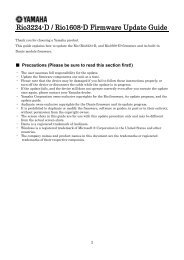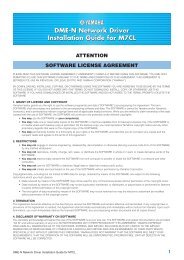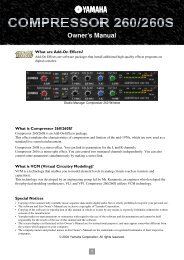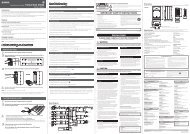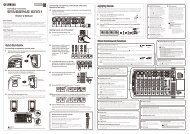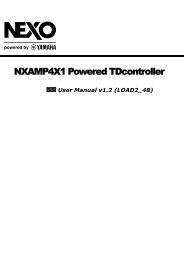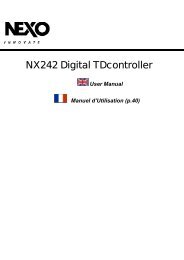Yamaha Digital Audio System Design Guide 8.42MB
Yamaha Digital Audio System Design Guide 8.42MB
Yamaha Digital Audio System Design Guide 8.42MB
Create successful ePaper yourself
Turn your PDF publications into a flip-book with our unique Google optimized e-Paper software.
11<br />
EtherSound EtherSound<br />
Products<br />
AuviTran<br />
Based in France, AuviTran was established around a core of staff members from Digigram’s EtherSound product development<br />
department. Applying specialist expertise and know-how, the company is focused on the development of solutions using<br />
EtherSound technologies.<br />
AVRed-ES Series of EtherSound Redundant-Link Management Units<br />
The AVRed-ES series provides a range of EtherSound redundant-link management units in a compact 1U rack size. These units ensure highly<br />
stable EtherSound connections using two redundant links. Offering a choice of Cat5 cable connectors or optical-fi ber cable connectors for<br />
input and output, the series adds support for a range of different systems.<br />
AVRed-ES<br />
Support for EtherCon connectors<br />
AVRed-ES/FoSC<br />
Support for optical SC duplex connectors<br />
AVRed-ES/FoNeutrik<br />
Support for OpticalCon connectors<br />
AVRed-ES/FoFibreco<br />
Support for Fibreco fi ber-optic connectors<br />
EtherSound Network Matrix<br />
AVM500-ES<br />
Coming in a compact 1U rack size, the AVM500-ES provides an EtherSound network matrix for simultaneously linking and routing of up to fi ve<br />
EtherSound networks, each with 64-in / 64-out channels. As such, this device can be used to confi gure an audio matrix with as many as 320<br />
inputs and 320 outputs. In large scale systems, furthermore, multiple AVM500-ES units can be distributed or joined together in a ring to create<br />
an EtherSound network with functional redundancy for guaranteed stability.<br />
Digigram<br />
Digigram was established in 1985, initially developing professional sound cards for PCs. And while developing and marketing a<br />
wide range of PC sound cards, network devices, and software, the company also worked on customizing the Ethernet protocol<br />
for using with network audio. In 1999, Digigram introduced the fi rst audio network products utilizing Ethernet technologies — a<br />
solution that it christened “EtherSound”. Since then, the number of manufacturers adopting EtherSound technology has grown<br />
steadily, making it one of the most commonly used protocols in today’s digital audio networks. At <strong>Yamaha</strong> and at many other<br />
manufacturers, advanced EtherSound-compatible devices are being continually designed and developed.<br />
EtherSound PCI Sound Card<br />
LX6464ES<br />
The LX6464ES is a PCI sound<br />
card for PCs providing 64-in /<br />
64-out EtherSound channels<br />
(when operating at 44.1 or 48<br />
kHz), and it can be connected<br />
to network devices using Cat5<br />
cables. When integrated into an<br />
EtherSound system in this way, a computer running DAW software<br />
can be used for direct recording of audio. In terms of audio quality,<br />
furthermore, the LX6464ES supports sampling rates as high as 192<br />
kHz (16-in / 16-out).<br />
<strong>Yamaha</strong> <strong>Digital</strong> <strong>Audio</strong> <strong>System</strong> <strong>Design</strong><br />
EtherSound PCI Sound Card<br />
LX1616ES<br />
The LX1616ES is a PCI sound<br />
card for PCs providing 16-in /<br />
16-out EtherSound channels<br />
(when operating at 44.1 or<br />
48 kHz). Although currently<br />
a scaled-down version of the<br />
LX6464ES, it is planned to<br />
expand this card to handle a maximum of 64-in / 64-out channels in<br />
the future through fi rmware upgrades. The LX1616ES has a fi xed bit<br />
depth of 24, and offers sampling rates of 44.1 and 48 kHz.<br />
AVS-ESMonitor<br />
AVS-ESMonitor is an application for Windows XP or Vista that can be used to set and monitor devices within EtherSound audio networks.<br />
Developed by AuviTran, this application can be downloaded free of charge from the company’s web site. EtherSound networks feature devices<br />
connected together in series in a daisy-chain confi guration — in specifi c terms, the Out connector of each device is connected to the In connector<br />
of the next device in the network. The fi rst device in the daisy-chain is referred to as the Primary Master, and the PC running AVS-ESMonitor is<br />
connected to this unit's In connector. The application then automatically detects all EtherSound devices in the network and displays them onscreen.<br />
In specifi c terms, AVS-ESMonitor identifi es the manufacturer ID, the model ID, the model name, and the corresponding number in the<br />
connection sequence for each networked device. Additional information on each device can be assessed by opening its Property screen.<br />
Laptop PC<br />
(AVS-ESMonitor)<br />
Primary Master<br />
MY16-ES64<br />
OUT IN<br />
HA Remote<br />
AVS-ESMonitor screen<br />
NAI48-ES End Loop NAI48-ES<br />
IN OUT<br />
IN<br />
MY16-EX MY16-EX<br />
PM5D<br />
Automatic detection<br />
Live Rec<br />
Select the device to be set from the network view<br />
on the left of the screen<br />
(End Loop set at<br />
final unit permitted<br />
to transmit data<br />
upstream)<br />
Tab views showing settings and other details for the selected device (right of screen)<br />
Tab views<br />
In AVS-ESMonitor, tab views are used to display information on the device selected from the<br />
network view on the left of the screen.<br />
● Properties tab<br />
As the name suggests, this tab displays the general properties of the selected device. In<br />
addition, the <strong>Audio</strong> Setup area can be used to set the sampling rate, number of channels,<br />
and other parameters.<br />
● Network Routing tab (Net Patch)<br />
Signal routing for the entire network can be displayed by selecting the Net Patch tab. Here,<br />
signals fl ow from the sources listed at the top to the receivers listed along the left-hand side.<br />
● Routing tab (I/O Patch)<br />
In the Routing tab, EtherSound channels can be assigned to the selected device. Output<br />
channels are displayed on the top; input channels, on the bottom. Using these grids, signal<br />
transmission and reception settings can be made for each device. In addition, this tab can<br />
also be used to set an End Loop.<br />
● Control tab<br />
If specifi c controls apply to the selected device, they can be set using the Control tab. If, for<br />
example, an MY16-ES64 expansion card is selected, you can use this tab to set HA Remote<br />
parameters for connected AD8HRs and to also set the slot on the digital mixer fi tted with the<br />
card.<br />
Starting at a unit designated as the Primary Master, an EtherSound network can transmit a total of 128 channels of audio signals; furthermore,<br />
all of this data — comprising 64 upstream and 64 downstream channels — can be transmitted on a single Cat5 cable. The channels on which<br />
this audio data is sent and received can be freely defi ned for each of the devices forming the EtherSound network, and the routing functionality<br />
provided by AVS-ESMonitor allows these settings to be made in an intuitive, graphical way. In terms of <strong>Yamaha</strong> products, this application<br />
currently supports the MY16-ES64, the NAI48-ES, DME Satellite ES series, and the SB168-ES.<br />
<strong>Yamaha</strong> <strong>Digital</strong> <strong>Audio</strong> <strong>System</strong> <strong>Design</strong> 12



